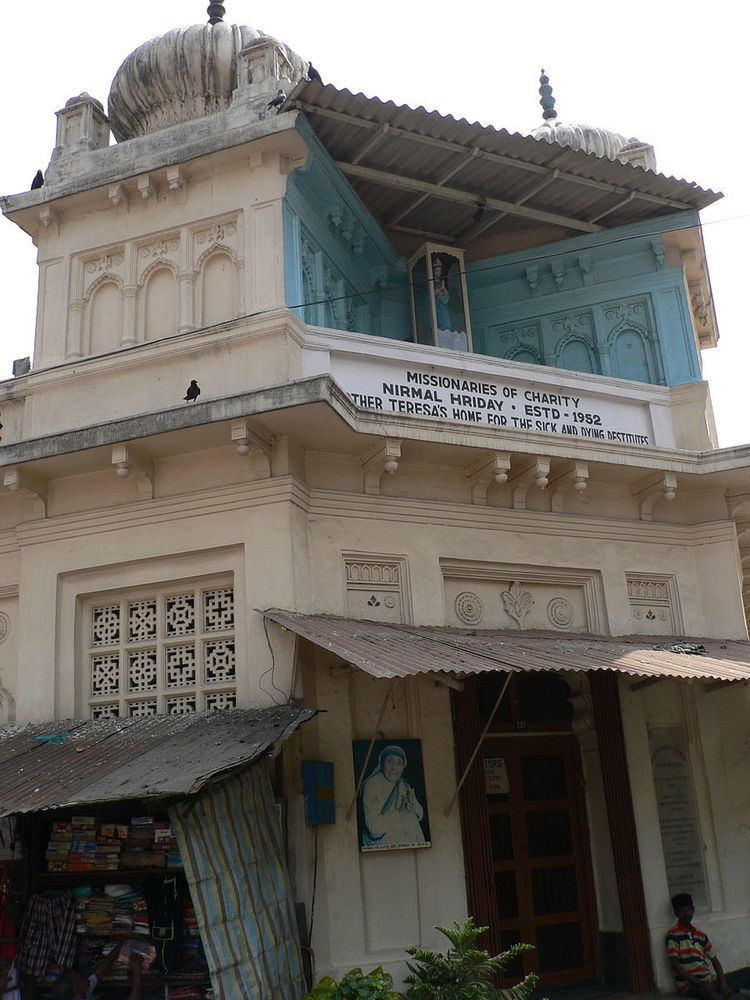 | ||
Kalighat, the Home of the Pure Heart (Nirmal Hriday) (formerly Mother Teresa's Kalighat Home for the Dying Destitutes) is a hospice for the sick, destitute and the dying established by St. Mother Teresa in Kalighat, Kolkata, India. Before Mother Teresa sought permission to use it, the building was an old abandoned Hindu temple to the goddess Kali, the Hindu goddess of time and change. It was founded by St. Mother Teresa on her 42nd birthday in 1952, two years after she established Missionaries of Charity in Kolkata..
Contents
St. Mother Teresa opened this free hospice in 1952, next to the famous Kalighat Kali Temple in Kalighat Calcutta. With the help of Indian officials, she changed an abandoned building which previously served as a temple for the Hindu goddess Kali into the “Kalighat home for the dying”, a free hospice for the poor. Later on she changed the name to “Kalighat the Home of the Pure Heart (Nirmal Hriday)”. People who were brought to the home received medical attention from the Missionaries of Charity and were given the opportunity to die with dignity, according to the rituals of their faith; Muslims were read the Quran, Hindus received water from the Ganges, and Catholics received the Last Rites. "A beautiful death," she said, "is for people who lived like animals to die like angels—loved and wanted."
Quality of medical care
In 1991, Robin Fox, editor of the British medical journal The Lancet visited the Home for Dying Destitutes in Calcutta (now Kolkata) and described the medical care the patients received as "haphazard". He observed that sisters and volunteers, some of whom had no medical knowledge, had to make decisions about patient care, because of the lack of doctors in the hospice. Fox specifically held Teresa responsible for conditions in this home, and observed that her order did not distinguish between curable and incurable patients, so that people who could otherwise survive would be at risk of dying from infections and lack of treatment.
Fox conceded that the regimen he observed included cleanliness, the tending of wounds and sores, and kindness, but he noted that the sisters' approach to managing pain was "disturbingly lacking". The formulary at the facility Fox visited lacked strong analgesics which he felt clearly separated Mother Teresa's approach from the hospice movement. Fox also wrote that needles were rinsed with warm water, which left them inadequately sterilized, and the facility did not isolate patients with tuberculosis. There have been a series of other reports documenting inattention to medical care in the order's facilities. Similar points of view have also been expressed by some former volunteers who worked for Teresa's order. St. Mother Teresa herself referred to the facilities as "Houses of the Dying".
Baptisms of the dying
St. Mother Teresa encouraged members of her order to baptize dying patients, without regard to the individual's religion. In a speech at the Scripps Clinic in California in January 1992, she said: "Something very beautiful... not one has died without receiving the special ticket for St. Peter, as we call it. We call baptism ticket for St. Peter. We ask the person, do you want a blessing by which your sins will be forgiven and you receive God? They have never refused. So 29,000 have died in that one house [in Kalighat] from the time we began in 1952."
Critics have argued that patients were not provided sufficient information to make an informed decision about whether they wanted to be baptized and the theological significance of a Christian baptism.
Some of St. Mother Teresa's defenders have argued that baptisms are either soul-saving or harmless and hence the criticisms would be pointless (a variant of Pascal's Wager). Simon Leys, in a letter to the New York Review of Books, wrote: "Either you believe in the supernatural effect of this gesture – and then you should dearly wish for it. Or you do not believe in it, and the gesture is as innocent and well-meaningly innocuous as chasing a fly away with a wave of the hand."
